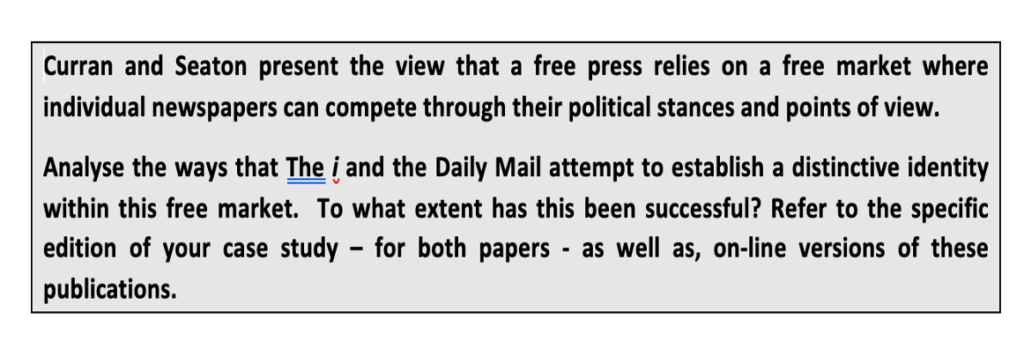
James Curran and Seaton looked at power and media industries and how conglomerates (a large company which consists of smaller companies) being driven by money and power. The ownership and control over small companies means they have power in multiple industries. The focus on profit means conglomerates will rarely take risks on projects and instead focus on making profit increasing media products. Therefore, the is limited variety of content. A quote by Curran and Seaton to avoid this is ‘Media policy should seek[…] to create the conditions of greatest possible competition, thus enabling consumers to exercise sovereign control. This produces media that people want, a wide range of choice, and media independence from government’ To simplify Curran and setons power and media theory is that that media producers have different rules. For example, if the media producer is paid for by the government it must remain unbiased Liberal Free press, therefore it should be free from interference and political control, as they should be neutral and unbiased.
Another relevant theory is Gramsci’s theory of hegemony. This is linked with the idea of capitalist state and claims that the state rules and has power through force and consent, with society being a realm of force into a dominant ideology. Hegemony refers to the idea that nothing is fixed and things such as culture and identity power can be changed and the media how the power to do so, much like Curran and Seaton who said the large media companies (driven by money) have power in multiple industries.
The I newspaper was introduced in October 2010 and was originally a sister paper to The Independent a considered Liberal newspaper. It was later bought by for £49.6 million by the daily mail and the general trust a newspaper considered to be less liberal with right wing political views. Regardless of their ownership The ‘I’ still has editorial independence meaning the daily mail and general trust don’t influence the contact published by the newspaper with the stories often being presented more factual are what is considered hard news. The conglomerated of the daily mail and the general trust manages a multinational portfolio of companies, giving them horizontal integration (process of a company increasing production of goods or services at the same part of the supply chain) with total revenues of almost £2 billion. The Daily mail was introduced much earlier beginning production in Created on May 4 1896. The magazine is owned by Viscount Rothermere & Family, with lord Rothermere Jonathan Harmsworth being chairman of various newspapers including the daily mail and the general trust (which have ownership of the I newspaper) and has accumulated a net worth of 1.9 billion dollars (august 2017).
A key component to the I newspapers is how it positions itself neutral, this is largely to do with it target audience of fast pace, comminutors of any age and all political views meaning a wide range of readers. The ‘I’ has a readership reach of 221,083, and is a free newspaper, this means that they do not rely on costumers buying their product but instead on advisers to create a profit and keep up production, meaning they are not aiming to reach a niche audience such as right wing positioned audiences allowing the newspaper to include their own views as well as remaining more neutral and giving information for audiences to decode and form opinions on themselves. An example of a story published by the newspaper was headlined ‘reasons to vote Trump’ written by Kate Maltby who lived in the USA in 2009, she talks about various reasons to support trump exposing the positives of his presidency, this is unusual for a left wing newspaper which tend to portray Trump in a negative light. The magazine however also published an article headlining ‘Why Donald Trump falsely declaring victory and claiming voter fraud in his speech has been so widely condemned’ reflecting more negative view on Trump. I think this is a positive thing as explained by Stuarts Halls theory of preferred reading where individuals are not only active in the process of interpretation and the construction of meaning, but they are also able to dismiss and reject dominant messages. The inclusion of article coming from a variety of different political stand points allows audiences to create their own opinions much like a quote from Curran and Seaton “Media policy should seek[…] to create the conditions of greatest possible competition, thus enabling consumers to exercise sovereign control”.
The Daily mail however has a more specific target audience of lower-middle class women are reach a much wider audience of 2.2million. Due to it large readership the newspaper holds a lot of power and openly positions themselves as right wing and in support of the conservative party. The magazine if known for publishing articles on supporting their views. An article recently published headlined ‘Donald trumped?’ on the front page clearly demonstrating their dislike for Trump. By doing reader who perches the magazine likely have a similar view something the newspaper does purposefully to get achieve readers. Curran and Seaton talk about conglomerates being driven by money and power, something the daily mail could be thought to do, by creating story headlines to deliberately incise audiences rather than portraying their personal politically views. However, the newspaper does also present their own view throughout the paper this could be seen as trying to persuade readers to adopt their views meaning free press is not fully achieved.
In conclusion, the political identities which the Newspaper has created may be influenced by the want to persuade reader for certain political gain or to increase profits.




